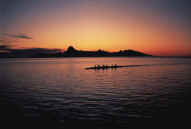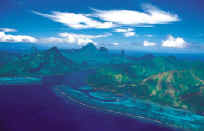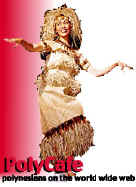





![]() History
History![]()
Just how
the Polynesian peoples came to populate their islands of the Pacific
is a subject of some debate. What is clear, however, is that they were
great sailors and navigators who  traversed
vast distances of open ocean to settle as far and wide as present-day
French Polynesia, Hawaii, New Zealand, parts of the New Guinea island,
Tonga and the Cook Islands. It's thought that they left South-East
Asia around 3000 or 4000 years ago and began to arrive in present-day
French Polynesia around 300 AD. Islands were originally ruled by
chieftains who commanded huge fleets of outrigger canoes; religious
practices at this time included human sacrifices.
traversed
vast distances of open ocean to settle as far and wide as present-day
French Polynesia, Hawaii, New Zealand, parts of the New Guinea island,
Tonga and the Cook Islands. It's thought that they left South-East
Asia around 3000 or 4000 years ago and began to arrive in present-day
French Polynesia around 300 AD. Islands were originally ruled by
chieftains who commanded huge fleets of outrigger canoes; religious
practices at this time included human sacrifices.
Some of the first European visitors, which included Samuel Wallis (1767), Louis-Antoine de Bougainville (1768) and James Cook (1769), returned with stories of a paradise on earth inhabited by 'noble savages' and Venus-like women whose sexual favours were freely offered to the visitors. Europe was abuzz with stories of a tropical haven of free love when Bougainville returned to Paris and this myth attracted the likes of Herman Melville, Robert Louis Stevenson and Paul Gauguin.
The most famous event in the region's recent history was the mutiny on the Bounty. It was on Tahiti and the Austral island of Tubuai that Fletcher Christen and his mutineers sought refuge after setting William Bligh and his faithful crew members adrift in a tiny open boat near the Tongan islands on 28 April 1789. And, ultimately, it was on Tahiti that the long arm of British law rounded up those mutineers who hadn't escaped to Pitcairn Island, and made them face British justice.
At the time of the mutiny, the Polynesian islands were ruled locally by important families - there was no all-prevailing ruler. The Polynesians had long realised the power of European weaponry and had courted earlier visitors to make allegiances in regional power struggles. While Cook, Bougainville and others had resisted this, the Bounty mutineers offered themselves as mercenaries. The Pomares, just one of the powerful Tahitian families, secured their services and, as a consequence, came to control most of the islands.
Soon
whalers and traders were calling in at the Polynesian islands, trading
weapons for fresh f ood,
introducing the notion of prostitution and spreading European diseases
to which the islanders had no natural immunity. Protestant
missionaries were deployed to put an end to all that nudity, erotic
dancing, wanton sex and heathen religion, and traditional Polynesian
culture rapidly fell apart. The islands' population plummeted and the
tyrannical Protestant missionaries razed Polynesian temples (maraes)
to the ground, forbidding any activities that were not devoutly
Christian.
ood,
introducing the notion of prostitution and spreading European diseases
to which the islanders had no natural immunity. Protestant
missionaries were deployed to put an end to all that nudity, erotic
dancing, wanton sex and heathen religion, and traditional Polynesian
culture rapidly fell apart. The islands' population plummeted and the
tyrannical Protestant missionaries razed Polynesian temples (maraes)
to the ground, forbidding any activities that were not devoutly
Christian.
And then the French came. They were already in control of the Marquesian archipelago to the northeast and after much filibustering, political browbeating and intimidation, managed to oust the English and secure most of what would become French Polynesia in 1842. Queen Pomare IV, who had already done much to unify the islands under her rule, was forced to yield to the French and spent the rest of her 50-year reign as a figurehead.
At the
turn of the 20th century the Polynesian islands became part of the Établissements
 expansion was introduced. Chinese labourers came to work on vanilla
and cotton plantations, and copra and mother-of-pearl production
became the cornerstone of the French Polynesian economy. Nearly 1000
Polynesians were sent to Europe to fight the Germans in WWI, and 5000
US soldiers landed on Bora Bora soon after the USA's entrance into
WWII to thwart the Japanese advance in the Pacific.
expansion was introduced. Chinese labourers came to work on vanilla
and cotton plantations, and copra and mother-of-pearl production
became the cornerstone of the French Polynesian economy. Nearly 1000
Polynesians were sent to Europe to fight the Germans in WWI, and 5000
US soldiers landed on Bora Bora soon after the USA's entrance into
WWII to thwart the Japanese advance in the Pacific.
The French had been testing weapons in the Sahara Desert, but Algerian independence caused General de Gaulle to announce in 1963 that the tiny atolls of Moruroa (often misspelt 'Mururoa') and Fangataufa in the Tuamotus would serve as the new sites for weapons testing, and the Centre d'expérimentations du Pacifique was born. As a result of continuing world opposition, the testing shifted underground in 1981. Of course the French claim that the testing is perfectly safe but don't seem prepared to conduct it on French domestic soil.
In 1995
when French president Jacques Chirac announced that a new series of
underground  tests
were to be conducted, the world reverberated with protest and
condemnation. Riots in the streets of Papeete saw hundreds of cars
overturned and buildings set alight, and the Chilean and New Zealand
ambassadors were recalled from Paris. The tests were completed in
early 1996 and the French government has since stated that the
nuclear-testing programme is over. After more than 150 separate tests
of up to 200 kilotons (10 times more powerful than the bomb which
levelled Hiroshima) the dust has once again settled around the atolls
of Moruroa and Fangataufa, though the longer-term effects remains to
be seen.
tests
were to be conducted, the world reverberated with protest and
condemnation. Riots in the streets of Papeete saw hundreds of cars
overturned and buildings set alight, and the Chilean and New Zealand
ambassadors were recalled from Paris. The tests were completed in
early 1996 and the French government has since stated that the
nuclear-testing programme is over. After more than 150 separate tests
of up to 200 kilotons (10 times more powerful than the bomb which
levelled Hiroshima) the dust has once again settled around the atolls
of Moruroa and Fangataufa, though the longer-term effects remains to
be seen.
There is now a considerable groundswell of calls for independence from France, but the orthodox political powers, headed by President Gaston Flosse, have made it clear this will not happen - at least not in the medium term - and France seems unlikely to relinquish its overseas territories. French Polynesia currently has a 41-member Territorial Assembly elected by popular vote every five years. The Republic of France is represented in the territory by a high commissioner appointed by the Republic. Over a 20 year period, ending in 1996, the island group took over internal management, but calls for independence are a permanent fixture on the political map.

![]()